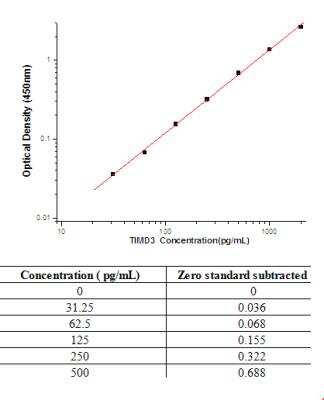TIM-3 Antibody Pair [HRP]
Novus Biologicals, part of Bio-Techne | Catalog # NBP2-79594

Key Product Details
Assay Type
Sandwich ELISA
Assay Range
31.25-2000 pg/ml (example only; lot dependent)
Sensitivity
31.25 pg/ml (example only; lot dependent)
Reactivity
Human
Product Specifications
Description
Solid Phase sandwich ELISA for the quantitative determination of Human TIM-3.
Sample Volume Required
100 ul
Conjugate
HRP
Scientific Data Images for TIM-3 Antibody Pair [HRP]
Sandwich ELISA: TIM-3 Antibody Pair [HRP] [NBP2-79594] - This standard curve is only for demonstration purposes. A standard curve should be generated for each assay.
Kit Contents for TIM-3 Antibody Pair [HRP]
- Mouse Monoclonal Detection Antibody (HRP-conjugated)
- Rabbit Monoclonal Capture Antibody: (Catalog # NBP2-89462)
- Standard
Preparation and Storage
Shipping
The product is shipped with polar packs. Upon receipt, store it immediately at the temperature recommended below.
Stability & Storage
Storage of components varies. See protocol for specific instructions.
Background: TIM-3
Dysregulation of TIM-3 expression is associated with autoimmune diseases as shown by studies where inhibition of TIM-3 using blocking antibodies worsened disease progression in experimental autoimmune encephalomyelitis (EAE) models of multiple sclerosis (MS) (2,3,5). Conversely, high levels of TIM-3 have been shown during viral infection as well as in many cancer types where its increased expression may be an indicator of poor prognosis (2,3,5). TIM-3 has emerged as a potential cancer immunotherapy target as preclinical studies blocking TIM-3 results in increased anti-tumor immunity and prevents tumor growth (3,5). Studies have suggested combination therapy of TIM-3 blockade with blockade of other checkpoint inhibitors such as programmed death 1 (PD-1) or lymphocyte activation gene 3 (LAG-3) is more effective than TIM-3 blockade alone (3,5).
References
1. Acharya N, Sabatos-Peyton C, Anderson AC. Tim-3 finds its place in the cancer immunotherapy landscape. J Immunother Cancer. 2020; 8(1):e000911. https://doi.org/10.1136/jitc-2020-000911
2. Das M, Zhu C, Kuchroo VK. Tim-3 and its role in regulating anti-tumor immunity. Immunol Rev. 2017; 276(1):97-111. https://doi.org/10.1111/imr.12520
3. Joller N, Kuchroo VK. Tim-3, Lag-3, and TIGIT. Curr Top Microbiol Immunol. 2017; 410:127-156. https://doi.org/10.1007/82_2017_62
4. Uniprot (Q8TDQ0)
5. Wolf Y, Anderson AC, Kuchroo VK. TIM3 comes of age as an inhibitory receptor. Nat Rev Immunol. 2020; 20(3):173-185. https://doi.org/10.1038/s41577-019-0224-6
Long Name
T Cell Immunoglobulin Mucin-3
Alternate Names
CD366, HAVcr-2, HAVCR2, KIM-3, SPTCL, TIM3, TIMD3
Gene Symbol
HAVCR2
Additional TIM-3 Products
Product Documents for TIM-3 Antibody Pair [HRP]
Product Specific Notices for TIM-3 Antibody Pair [HRP]
This product is for research use only and is not approved for use in humans or in clinical diagnosis. Antibody Pairs are guaranteed for 6 months from date of receipt.
